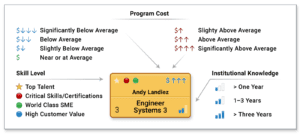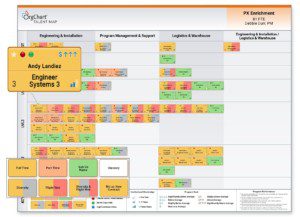Visualizing, Talent Mapping, and Analyzing to Optimize Workforce Planning
For one company, advance warning of talent gaps gave management leverage to increase profits, improve customer satisfaction and reduce flight risks by using a unique visualization.
We’re in trouble.
“I can’t tell you how many status reports I get telling me everything is just fine,” confided the VP of a large defense contractor. “We have a big problem. We are constantly getting blindsided with talent gaps on our most critical programs. I’m told everything is perfectly on schedule, but then we’re getting ugly surprises every day. We aren’t hiring fast enough, we have employees leaving, we discover we’ve hired redundant talent – all leading to significant cost overruns and missed delivery dates. It creates a horrible domino effect as we have to pull resources from other projects or pay steep premiums for contractors. To make matters even worse, customer satisfaction has been so low that we’ve lost three big clients – resulting in hundreds of millions in lost business to our competition. If only we could have seen these issues earlier. I need a solution that gives me a way to visualize the talent issues on a project by project basis across my organization – with enough of an early warning that I can do something about it.”
This was the issue a VP of HR had to solve: how to foresee talent threats across all the company’s critical programs.
Talent Map: Mapping Talent to see the Future
The client had plenty of data, but what they didn’t have was a way to get useful information. Everyone was doing something different, nothing was standardized. “If we can develop a common dataset for these presentations, then we can make continuous improvements that all of our critical projects will benefit from,” is what the VP of Finance told us. After sitting down with the VPs and gaining insight and understanding their pain points, our initial challenge was to devise a way to normalize the right data into a standardized view that would empower management with insight and control over program risks, particularly related to talent.
We created the Talent Map concept so management could quickly analyze as many programs and workgroups as possible. We collaborated with the client to determine the kinds of information needed, developing a visual layout so that management would have a clear picture. The information sources used for the map were the company’s HRIS, manager interviews, and client interviews for both employees and contractors. Thus both objective and subjective data were compiled into the map. Each person was represented as a card with standard data fields, symbols, and coloring.
The result is an informative snapshot of an individual revealing their talent profile in a compact, easy-to-read format. As you can see, Talent Map created a snapshot of the person in a standardized view so all the employees can be compared easily and quickly. The example in Figure 1 shows a Systems Engineer, who is a full-time employee with critical skills, recognized as top talent, costing above industry benchmark, highly experienced, and with a solid performance rating. As you can see, Talent Map created a snapshot of the person in a standardized view so all the employees can be compared easily and quickly.
“We have 150 strategic programs that need to be talent mapped. I can’t picture us doing this manually in PowerPoint,” said the VP of HR. The client feared this would be too complex and labor intensive. We effectively addressed their concerns by automating the Talent Map process.
The Talent Map Layout
The next challenge was determining the best way to present each program talent pool to management. So rather than using an organization chart hierarchy they opted for a “soft hierarchy” where individuals would be grouped by job function and management level. The matrix assembled would support the executive’s process for evaluating the strength and cost-efectiveness of the team in place.
With each of the resources profiled and organized into a matrix of level and function our client now had a standardized view of the organization’s talent.
Automation
Historically the client had much of the necessary information to give early warning of program risks, but it was piecemeal and inconsistent. We automated the aggregation of information into presentations that gave a holistic perspective. A new standardized view and repeatable process has positioned the client for repeatable success.
Managing Teams
Since Talent Map is interactive, management is able to identify gaps and then move individuals to test out changes to the teams. But even beyond identifying gaps, the common scenarios that management encounters – programs ramping up, programs behind schedule or exceeding budget, loss of key resources – they all benefit from this solution. And where a team is ramping down they can allocate talent to new programs without negative impacts. “The amount of talent information we have at our fingertips makes it much easier to effectively respond to change. Whether moving employees within a program or to a new program, we are able to make transitions more gracefully,” reports a portfolio manager.
As programs and organizations encounter new talent requirements, the maps facilitate the efficient identification of best fit employees. Scarce, in demand, and highly-skilled resources become easier to identify and share across the company. This reduces the need for expensive contractors to fill expert positions on an emergency basis.
The Results
A pilot project was designated for a “test run” of the Talent Map, and program leadership met with the executives and HR.
As a result the Program VP commented, “It became immediately clear we were at risk of losing 20 percent of our resources before project completion – which would be a disaster. That information is now being fed into our plans for employee retention.”
Another executive noted that some of the most senior client interfacing positions were actually third-party resources. “We are trusting non-employees to represent us to our clients. This poses a serious risk to client intimacy when we use contractors at this level.” This was a valid concern because shortly thereafter the client was lost to the competition.
In both of these cases – loss of clients and unmanaged flight risk – the Talent Map quickly exposed significant threats to the business.
The Talent Map effort gave impressive results within a year. Unmanaged fight was reduced by over 40 percent. No clients were ever lost on programs using the Talent Map process. Management now had an advanced warning of these threats.
March 2016 • Workforce Solutions Review — „Product Focus“ • www.ihrim.org
OfficeWork Software provides innovative solutions enabling our clients to successfully manage organizational change.
Our software helps organizations manage, model, and align the workforce. Complete the form above to get a free one-hour assessment of your organization’s talent risk exposure. During this assessment you will:
- Identify strategies to expose hidden talent risks
- Learn how to avoid being surprised by status reports
- Identify employee flight risks
- Expand your knowledge of visualization strategies to manage workforce transformation






